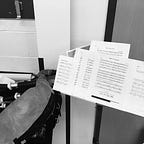Controlling Performance Anxiety With Visualization — Part 1
Your heart races, your palms sweat. Your arms are shaking as you try to calm yourself. A few quick breaths, and you strike in. You are on the boards for an important competition. Familiar?
Stage fright, stress, nerves, adrenalin…performance anxiety is known under many names.
“Nerves are part of what we do,” according the noted violinist Itzhak Perlman, “and the thing is to be familiar with them. It’s not about getting rid of them.”
In the previous post, I mentioned that there were three aspects of performance anxiety: the physical, the mental, and the emotional. We discussed consciously using your breathing to reduce the physical effects of performance anxiety such as an elevated heart beat. In this post, we will discuss using visualization to combat the mental and emotional effects.
The thrill of performing is often accompanied by stress. No one knows that better than an downhill skier. In the downhill, the difference between a spot on the podium and a finish back in the pack can be a matter of turning at the right time. If you watch a downhill skier before a race, you will often see them, eyes closed, visualizing their run down the course. They know precisely when to turn in order to navigate the course in the most efficient manner. In their mind, they are running the course, in detail.
Visualization is an important tools that has been used in sports and is used, increasingly, in music. Michelle Anderson, over at Clarinet Mentors is an advocate of visualization as a technique to combat performance anxiety. However, she notes that visualization must be done in detail. If you think of visualizing a performance of “The 79ths Farewell to Gibraltar,” we should be able to visualize every note:
C (ALAP)
D (ASAP)
G gracenote to E (ALAP)
F (ASAP)
Double E
…
Having a tune memorized can help with visualization. But, a downhill racer does not show up and begin visualizing. The skier will run and learn the course while applying their skills to execution. The skier will then visualize a successful run. Just as the skier relies on experience to visualize, we, too, must rely on our knowledge and skill to visualize a perfect performance. That starts in the practice room.
We cannot perform a piece perfectly if we have not practiced it perfectly. Ithzak Perlman is infamous when signing autographs for fellow musicians. In addition to his John Hancock, he will write the phrase “practice slowly.” We can learn to play a piece perfectly by practicing it slowly and deliberately. By practicing slowly, we can focus on executing each embellishment and movement correctly. We also learn how the piece should sound by practicing slowly. We can mentally associate the sound with the notes and the physical sensations associated with executing those notes. In one setting of the “79ths,” for example, we have a run that begins on A (ALAP) and goes to B (ASAP) with a grip to a C (ASAP). When we execute the grip from B to C correctly the notes of the grip pop and the fingers almost feel as if they are bouncing off the chanter. We can associate that physical feeling with the sound. We can also see the notes on the staff in our minds, we can almost recite the notes as we execute the run. These are important details to include in your visualization.
Visualize your breathing: If you can consciously control your breathing and blowing technique on the bagpipe, then you can see this control in your mind’s eye and include breathing in your visualization. Visualize yourself walking up to the boards, addressing the judge, placing your instrument on your shoulder, striking in, and then consciously controlling your breathing as you warm up your pipes. Then, visualize moving from consciously controlling your breathing, letting your training take over as your breathing becomes second nature, and visualize yourself tuning your pipes. Hear the notes in your mind as your drones come into tune, relate the feeling of the drones coming into tune into your visualization. After you’ve visualized tuning your instrument, move back into conscious control of your breathing.
As Noa Kageyama, over at the bulletproofmusician.com, notes, “when stressed, our bodies have a tendency to revert to shallow, rapid, chest breathing. Doing so keeps us in fight or flight mode.” When we experience performance anxiety, we may revert to shallow breathing. This can reinforce the mental and emotional effects of performance anxiety. If we are suffering from self-doubt or loss of focus, shallow breathing may exacerbate those mental effects. Similarly, shallow breathing can wreak havoc upon the mental effects of performance anxiety; shallow breathing can magnify mental anxieties.
If you can make yourself consciously aware of your breathing, you will be practicing a mindfulness exersize. As you focus on your breathing, you can reduce your heart rate which, in turn, can help to calm the mental and emotional anxieties that you may be experiencing. If you can visualize consciously controlling your breathing, you elicit a physical response of bringing your breathing under control. Visualization provides you with the opportunity to practice your technique, and your performance piece, prior to a competition. If you include visualization of your breathing in your overall visualization, you will have practiced calming yourself and helping yourself to mitigate not only the physical effects of performance anxiety, but the mental and emotional as well.
Take Action
3 Secrets to Better Competition Results
Dealing with Performance Nerves and Misc Q&A
The Nerve Buster Game — Defeat Performance Anxiety with Digital Recording
